Shark RSF 3 Motorcycle Helmet
The Shark RSF 3 apparently replaces the late and lamented RSX in the Shark helmet lineup for 2009.
The RSF 3 is an update to the popular RSF2i.
It has typical Shark quality and focus on safety as do all of the other Shark helmets in my experience.
After wearing the new Shark RSF 3 for the past few weeks, I’ve come to the conclusion that Shark is now my favorite motorcycle helmet manufacturer.
The company makes what I think are the highest quality motorcycle helmets available.
All of the Shark helmets I’ve seen have beautiful graphics combined with an outstanding surface finish with thick clear coat.
The parts always seem to work as expected and everything feels tight and secure and the helmets just feel strong and safe.
The padding and liner material is typically soft and comfortable.
And one of the best things about the company is their total dedication to safety, with helmet shells and special EPS shapes designed to spread the impact in a way that will hopefully minimize injury to the rider.
The RSF 3 is new for 2009 (although it was first released in 2008) and follows that same Shark tradition.
The only thing that might be an issue for some is that Shark helmets seem to all have an internal fit biased towards the long oval.
If only Shark would realize that there’s more than one head shape, I do believe they’d be the Helmet Kings of the World.
By the way, this is not a problem that is just isolated to Shark; all of the other helmet manufacturers, with the exception of Arai, don’t yet understand or haven’t made the effort to address different head shapes.
Why they let Arai own the market for this feature is beyond me.
But, in any case, you pretty much can’t go wrong with a Shark helmet, in my opinion.
Where to Buy Shark RSF 3 Helmet
Check Reviews & Prices on Amazon Check Reviews & Prices On RevZillaSee More Motorcycle Helmets, Motorcycle Visor, Motorcycle Intercom
The Shark RSF 3
The RSF 3 apparently replaces the fantastic RSX (review) in the Shark helmet lineup. No word that I know of from Shark on whether or not the RSX will be continued as a next generation.
So the demise of the RSX thins out the Shark lineup somewhat; the RSF 3 apparently will fill that role. The RSF has a heritage also; it has been evolved from the RSF2i, which was a popular helmet in Europe.
The RSX is probably the most solid, highest-quality helmet I’ve ever experienced — and it also had that thick 3 mm visor.
From my reading of Shark’s marketing brochure, it looks like only the RSR2, which is Shark’s top-of-the-line race helmet, will continue with a 3 mm visor in 2009, and I think that’s a big mistake.
The 3 mm visor was a unique characteristic of Shark helmets that distinguished them from the rest of the competition.
It also worked better, in my opinion, because the thick polycarbonate kept the visor from flexing as it was rotated up and down, which is a pet peeve of mine.
Plus, the 3 mm thick visor was safer — Shark themselves tout the 3 mm thick visor on the RSR2 as “F1 type, enhanced safety”.
For a company that is so focused on technology and motorcycle helmet safety, it just seems strange to go to the same thickness visor that everyone else is using.
Could it have been a matter of cost? Who knows, but I can’t believe that extra millimeter would cost all that much more?
How about it Shark? At the very least, offer it as an option for all your helmets. I’d pay extra for it!
I will grudgingly admit though that in reality, few owners may notice the difference. We measured the visor on the RSF 3 shown here at 2.1 mm thick, which is actually about 0.1 mm under the average helmet visor thickness.
It works well (I’m getting ahead of myself here) in all other respects, as you’ll learn when I get to the visor section, although it does not have the same never-twist feel of the 3 mm version on the RSX.
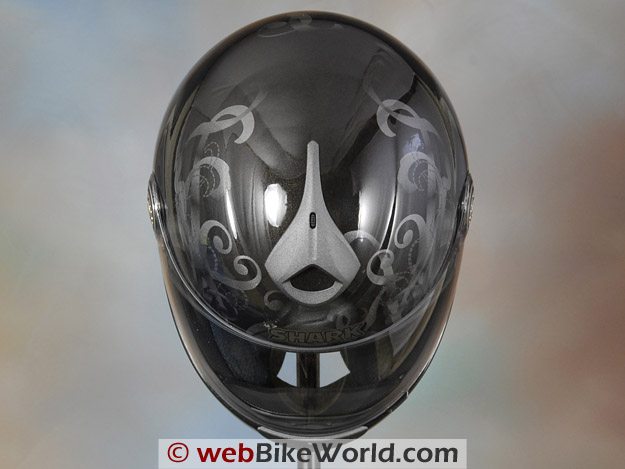
Paint, Graphics and Overall Quality
Visor aside, what we have here is a very nice helmet, very well made, with an excellent and super-shiny clear coat. All of the parts fit perfectly and everything lines up evenly with very close tolerances, and all works with precision.
The visor does fit very tightly to the helmet shell with a tolerance rarely — if ever — seen on motorcycle helmets.
The RSF 3 eye port also includes a nice, thick gasket around the entire circumference.
Shark has been expanding and experimenting with artistic graphics patterns over the last couple of years — the art department is now just as important for selling helmets as anything else — and the dark charcoal “Kobe” pattern shown here is a winner.
It has a subtle design with some depth that isn’t apparent in the photographs. The pattern looks like a decal under the clear coat, which creates a few raised edges here and there at the edges of the decals.
These can be felt where the decal meets the paint, and this may bother those who sit and stroke their helmets at night.
There are many color patterns available in the RSF 3 model, but for those who like dark or black helmets (and there are many), this Kobe design has the look while still offering a big dose of style.
The clear coat is excellent and almost as smooth and shiny as the DOT version of the Shark Evoline we reviewed recently, which is a stunner.
You can see in these photos that it was very hard to keep the studio lighting reflections off the very glossy RSF 3 surface as we were taking the photographs.
Score: Overall, I’ll give the Shark RSF 3 an “Outstanding” rating for the paint and the finish and overall quality. See the ratings scale in the summary table at the bottom of this page.
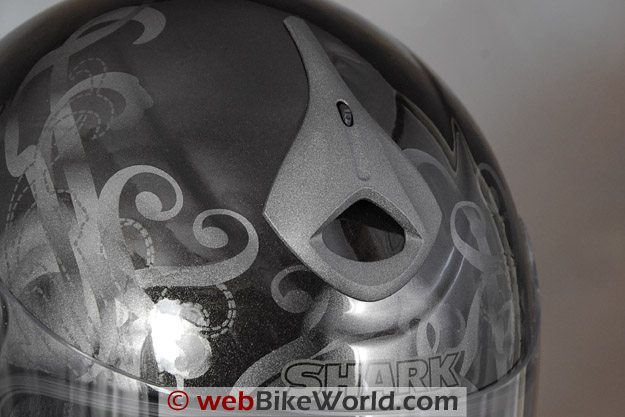
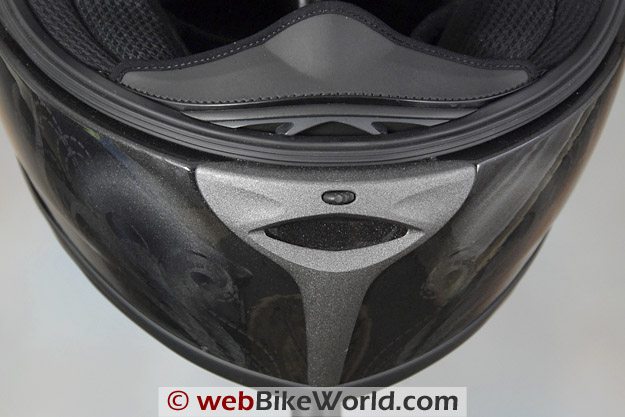
Where to Buy Shark RSF 3 Helmet
Check Reviews & Prices on Amazon Check Reviews & Prices On RevZillaSee More Motorcycle Helmets, Motorcycle Visor, Motorcycle Intercom
Helmet Shape and Fit
Most of the Shark helmets I’ve tried fit me without problems, but I was asked to evaluate the RSF 3 because the Editor has a much rounder head, which isn’t quite compatible with the fit of the RSF 3.
I’ve worn the Shark RSX many times, and my feeling is that the RSF 3 and that helmet have an identical internal shape, so they fit the same. The RSF 3 shown here is a size XL, and I probably could have used a size large instead, but it’s close enough.
For reference, other helmets that fit like the RSF 3 include the Scorpion EXO-700, which I think has a very similar internal shape as the RSF 3; also the Fulmer D4 we reviewed recently and the AGV Stealth.
The fit of the RSF 3 is not quite as round as the Shoei RF1000 and Rick says it’s definitely not as round as the Arai Quantum II.
If you read the webBikeWorld review of the Shark Evoline DOT, you’ll notice that the same helmets were used in comparison to the fit of the Evoline, which tells me that Shark as a template for head shapes that they’re using in most or all of their helmets.
The Shark RSi is even more “long oval”, and the S 650 is probably closer to the RSi than the RSF 3 also.
I know the Editor and others have a wish that Shark would make a helmet with an internal fit specifically designed for round shaped heads.
This could increase the customer base, so it’s not clear why Shark — and other helmet manufacturers — don’t add different internal shapes to their product lines.
It would be nice if all human heads came in the same shape, then we wouldn’t have to worry about that, but they absolutely don’t, so why make a helmet that only fits one shape?
Nevertheless, for me — and, I suppose, for the majority of motorcyclists — the RSF 3 is a “neutral” to “long oval” shape that fits just fine.
In terms of sizing, the XL fits as expected for an XL; I’d guess a 61-62.5 cm head in the correct shape would be perfect.
For more information on helmet sizing, see the wBW Motorcycle Helmet FAQ for a discussion on choosing and fitting a motorcycle helmet and an illustration of human head shapes.
And don’t forget that choosing the correct helmet shape is crucial for both comfort and safety.
Like the Shark Evoline, the RSF 3 has a “deep” shell shape that comes down lower than my chin.
We believe that some of the European helmets are being redesigned with a deeper chin bar and helmet shell to meet SHARP helmet safety standards (our report).
The chin bar seems noticeably taller or deeper than other helmets.
This has some benefits, because it may help keep the noise low and, along with the standard chin curtain on the RSF 3, it blocks a lot of unwanted air from rising up from under the helmet.
On the other hand, the RSF 3 does not have vent passages through the chin bar, so the combination of the chin curtain and larger than average chin bar can make it a bit toasty inside.
Score: I’ll give the Shark RSF 3 an “Excellent” rating for the fit and shell shape.
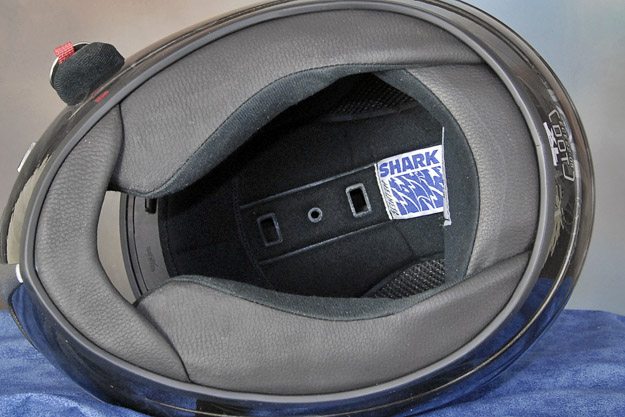
Helmet Liner and Padding
Some inexpensive helmets (and some expensive helmets too) use lining materials and padding that just aren’t very comfortable.
It’s not that they’re terribly uncomfortable; it’s just that when compared to helmets like the Shark RSF 3 and helmets made by Arai and maybe some others, there is a difference.
Shark helmets as a rule have very comfortable lining material and form-fitting padding, and the RSF 3 is also excellent in that respect.
The lining feels very similar to the comfortable material used in the RSX, and the padding and construction of the liner lends an overall feeling of quality to this helmet.
The lining is fully removable and I’m assuming that different sized cheek pads are available, like they are for the RSX, although I can’t confirm this.
Score: I’ll give the Shark RSF 3 an “Outstanding” rating for the liner, padding and interior comfort.
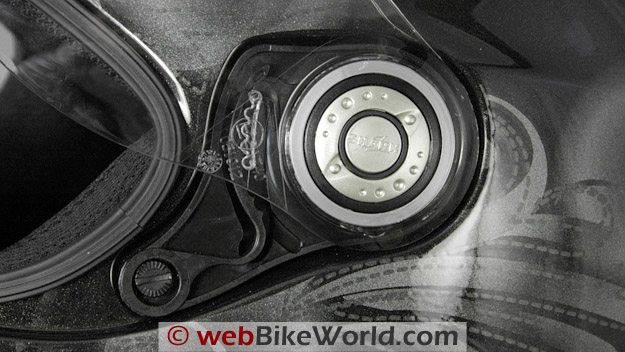
Ventilation
The RSF 3 has what looks like an evolution of the Shark top vent design that I first experienced on the original Shark RSR.
This “sugar scoop” top vent is — or was — almost a Shark trademark. It worked pretty nicely the past and overall I’d say it works well on the RSF 3.
A small serrated wheel is turned back and forth to open and close the vent on the RSF 3. The wheel could probably be larger, and the detents stronger, but in general it works well and the top vent does seem to provide an adequate, if not overwhelming, amount of air flow.
The EPS liner inside the helmet has channels and there are vent holes through the lining to let in the air.
The vent does whistle slightly at certain angle of attacks, caused by air rushing over the opening. When the vent is closed, the noise all but disappears.
The chin vent also has the serrated wheel and you’ll have to remember that left is open and right is closed.
This isn’t very intuitive; I think it would have been better to duplicate the vertical movement used on the top vent, with down for closed and up for open on the chin vent also.
While the chin vent opening may appear large on the outside, the horizontal switch only works to slide a series of “teeth” back and forth across other teeth to open or close the vent, much like the system used by KBC.
So the vent opening is immediately only 50% efficient, because half of the surface area is blocked by the closed teeth.
The big disappointment is that the RSF3’s chin bar does not have air vent passages, so what air does enter the chin vent only flows up in back of the visor and not directly on to the rider’s face.
The combination of the deep chin bar, the large chin curtain and the small vent with no holes in the chin bar results in a hot environment for the lower part of the face.
I had to remove the chin curtain on this helmet, which helps by allowing air to flow up from underneath the chin bar. I think that a pair of direct air passages through the chin bar would be a better idea.
But I wonder if yet again the helmet is being designed to meet SHARP testing and perhaps holes in the chin bar would give it a lower score?
Score: I’ll have to give the Shark RSF 3 a “Good” rating for ventilation, with the top vents providing what I think is slightly better than average ventilation but the chin vent system drops the score.
Where to Buy Shark RSF 3 Helmet
Check Reviews & Prices on Amazon Check Reviews & Prices On RevZillaSee More Motorcycle Helmets, Motorcycle Visor, Motorcycle Intercom
Noise Levels
The Shark RSF 3 is generally quieter than average, in my opinion, compared to other helmets I’ve reviewed or which I wear. The large and deep shell with thick padding and, for me, a good fit, conspire to keep noise levels relatively low.
The top vent does tend to whistle slightly, but it’s not that loud and probably more noticeable only because of the relatively low noise levels otherwise.
I notice no undue rumbling or low-frequency booming from underneath when riding behind a short fairing — it’s there, but I believe the deeper shell shape helps to attenuate the volume.
As always, for more information on helmet noise, visit the wBW Motorcycle Helmet Noise page.
Also, note that we always wear high-quality, correctly fitted ear plugs when riding — see the wBWEarplugs and Hearing Protection page for more information on choosing and wearing earplugs.
If you don’t wear ear plugs, all bets are off — every motorcycle helmet is dangerously noisy, in our opinion, and your hearing is as precious as your eyesight, so don’t mess with it. Wear ear plugs.
Also, different riders will experienced different noise levels due to a variety of factors including most importantly the fit of the helmet to the rider’s head; ear plugs; motorcycle type; windscreens; neck shape and even clothing.
Score: I’ll have to give the Shark RSF 3 an “Excellent” rating for overall slightly lower than average noise levels.
Face Shield
The clear face shield has 6 detents to hold it open as it rotates upwards. It starts with a small demisting opening and goes up from there.
This is different from the Shark RSX, which has a continuous friction held visor opening system. The visor is optically very clear with no distortion.
The visor seems relatively firm and not flexy, even though it’s 33% thinner than the 3 mm thick visor on the Shark RSX. I think the new visor rotating system with its large round buttons on the side of the helmet helps to allow the visor to rotate up and down with less binding.
The visor also now includes a lifting tab on the lower left, which is different than the RSX, which had no tab but an indent in the helmet shell.
The new push-button visor removal system works well. Lift the visor all the way and push in the (stiff feeling) button on the side and the visor pops off (demonstrated in the video below).
Push the button again to replace the visor. It’s better to do this with the helmet on a table facing away from you.
The visor is coated with and anti-fog and anti-scratch treatment, and it does seem to work well to prevent fogging, which is important due to the more confined feeling behind the large chin bar.
The visibility from the eye port is about average. It’s somewhat better than the RSX, which limited the peripheral vision due to its narrow dimensions. But the large/tall chin bar on the RSF3 does slightly impede downward vision, and the side-to-side vision through the eye port is only average.
Score: The Shark RSF 3 gets an “Excellent” rating for visor quality and operation. It could have been an “Outstanding” if the visor was thicker!
Helmet Weight
The Shark RSF 3 in size XL shown here weighs a light 1504 grams (3 lbs., 5.0 oz.). This is actually very light, and the RSF 3 is even lighter than the HJC FS-15 Carbon reviewed here not long ago!
It’s in the same neighborhood as the Nolan N94 Casey Stoner Replica (review) in size XL at 1499 grams (3 lbs. 4-7/8 oz.) and the URBAN N20 Astro (review) in size L at 1511 grams (3 lbs. 5-1/4 oz.) and the HJC FS-15 Carbon, coming in at 1514 grams in size XL (3 lbs. 5-3/8 oz.).
It’s sometimes (usually) difficult to tell if a helmet is light or not when first handling it, before it goes on the scale. And the RSF 3 is a bit deceiving, because the large and deep shell may make it seem heavier than it really is.
But 1504 grams for a helmet of this type is very good indeed, and it wears light and the simple but straightforward aerodynamics give it a solid feel.
See the wBW Motorcycle Helmet Weights page for the complete chart, comparing the weights of every helmet we’ve reviewed.
Score: The Shark RSF 3 gets an “Outstanding” rating for low weight combined with a robust feel.
Miscellaneous
This RSF 3, like the Evoline DOT version, is labeled as meeting both DOT and ECE standards. As we reported in the Evoline DOT review, it is our understanding that the ECE frowns upon labeling helmets sold outside of the ECE as meeting ECE standards.
Sounds pretty fussy to me — why not help your manufacturers brag a little bit in worldwide markets and maybe create some more sales — and jobs?
As was mentioned in the Shark Evoline DOT review, “In any case, it’s nice to know the helmet meets two excellent motorcycle helmet safety standards”.
The RSF 3 has a double-D-ring helmet retention system when sold in North America.
Conclusion
The Shark RSF 3 is an excellent, high quality helmet that feels both comfortable and strong while also coming in as a super-lightweight.
Other than what some may consider to be the minor nitpicks of the thinner visor and single internal shape, this is an excellent choice for anyone looking for a very high quality helmet that meets both DOT and ECE standards.
And don’t forget, Shark offers a 5-year warranty with the RSF 3 and the brand is well supported in the U.S.A.!
UPDATE: Shark sent us a note after publication of this review. In part, it said “Shark is currently developing a new high end helmet that will also (and again) carry the 3 mm shield. So don’t worry, we are definitely not going the easy way by “looking like the others”!
Also, look for some new helmets from Shark; a completely new injection molded design, the S700 and S900!
| wBW Review: Shark RSF 3 Helmet | |
|---|---|
| Manufacturer: Shark Helmets | List Price (2009): $299.95-$349.95 |
| Colors: Varied | Made In: Thailand |
| Sizes: XS-XL Shell Sizes: Unknown | Review Date: April 2009 |
Where to Buy Shark RSF 3 Helmet
Check Reviews & Prices on Amazon Check Reviews & Prices On RevZillaSee More Motorcycle Helmets, Motorcycle Visor, Motorcycle Intercom
Note: For informational use only. All material and photographs are Copyright © webWorld International, LLC since 2000. All rights reserved. See the webBikeWorld® Site Info page. Product specifications, features and details may change or differ from our descriptions. Always check before purchasing. Read the Terms and Conditions!
Owner Comments and Feedback
See details on submitting comments.
From “A.D.” (01/11): “I’d just like to say how excellent your site is and how you saved me a lot of time when I was looking around for a new helmet.
The Shark RSF3’s were not on the shelf in Australia when I first found your website due to dealers still holding old stock.
But the national distributor had them hidden out the back and was good enough to send one through my local dealer upon request. It was very possibly one of the first to be aired in Oz (Sept 09).
Having researched your head shape guide, I was impressed with the way the Shark RSF3 fitted perfectly straight up although a bit firm on the cheek but who wants a loose helmet.
After having had an old Shoei, an Arai for many years then a HJC CL-14 the first thing that really impressed was being able to look sideways at speed without nearly being ripped off the bike, superb aerodynamics.
A couple of years ago the Labour government imposed speed limits in the Northern Territory of Australia which were previously unlimited on the open road, acknowledged by some but not all (the new limits that is), which was a good test of both bike and gear.
It was not uncommon to legally sustain speeds of 240 km/hr + for prolonged periods of time. All day if you so desired.
The Shark didn’t wobble, vibrate, whistle excessively or lift in an undue manner, unlike ones wallet frequently did at the petrol station. 16 months on and the visor is still in good condition, the airflow controls are still tight, paintwork is still glossy and the fit is still firm.
Thanks for steering me towards an excellent product that has proved to be really good value for money.
Since moving to North Queensland (a reasonably heavily policed state) I’ve purchased a Triumph Speedmaster and the helmet works fine on that too.
My two bikes in the Territory were a Ducati S2 MILLE with fully flowed heads and a Kawasaki ZRX 1200 Eddie Lawson replica. Have fun, ride safe.”
From “J.S.” (6/20): “I received my new Shark RSF3 helmet 6 days ago. I live in an area where it is impossible to try all the different brands of helmets before buying, so I had to rely on an internet store that has a good return policy and your helmet review to select a helmet.
After using the helmet for 6 days I think your review is very accurate; however I would add a couple things.
When I first attempted to put the helmet on I was sure I had gotten the wrong size, I checked, it was a XL just as I had ordered. It seemed there was no way it was going to fit on my head and I was about ready to put it in the box and send it back.
I decided to try once more to put it on, It was very tight over my ears, almost painful pulling it down over my ears, but once I had it on it fit very well. I slipped it off and on a couple more times and decided I would give it a try.
The other thing I noticed right away was the cheek pads were tight, however not having them in my previous helmets probably made them more noticeable. I called the supplier to see if there were thinner ones, not available.
He recommended that I let them “break in” or remove them and compress them over night. I chose to let them break in and they seem to be OK.
I found my old Silks helmet liner I hadn’t used in a couple years and started using that which makes it much easier to put the helmet on.
The helmet is a little warm because of the tight fit around the neck, chin and cheeks.
On a hot day and not moving it could become a little uncomfortable. I have found riding under 60 mph I like to open the face shield to the first detent, increasing the vent flow and the noise level is still low.
Also with my helmet liner, I have been able to wear my eyeglasses, just slip them under the liner and they slide right over my ears.
I like this helmet better than my Nolan N102 because the fit is better and much lighter and better than my HJC Sy-max II because of the fit, noise level and weight.”
Editor’s Note: Some helmets with a “race fit” have a tapered fit around the bottom of the shell.
From “J.T.F.” (6/10): “I received my the Shark RSF3 a week ago and will be be putting it back (up for sale). It’s a beautiful helmet but there are three areas that are causing me to sell it.
First, I wear glasses and am having a difficult time getting my glasses to comfortably fit inside the helmet and getting the bows over my ears.
Two, whenever I hit about 35-40 MPH I hear a low rumbling sound. I think it’s the same effect as blowing over the top of a soda or beer bottle.
Three, I didn’t find the air vents particularly useful. And the detents hardly move. I thought perhaps my helmet’s detents were defective until I watched your video.
Aside from the glasses issue, I like how the helmet fits. Very snug and comfortable, but the other issues I mentioned are causing me to sell. I’d like an Arai Profile Force but can’t find one in my price range.
And before I buy again I’m going to give any prospective helmet a test fitting.”
Editor’s Reply: Thanks for the feedback. What you are saying I think can pretty much be said of any/many motorcycle helmets; i.e., vent noise, poor air flow, noise around the bottom… Unfortunately, that seems to be the rule pretty much for every helmet we’ve tried!
Also, very few helmets are compatible with eyeglasses, and fitting a pair inside a helmet also depends heavily on the way the helmet fits and the way the ear pockets are shaped.
I’ve pretty much given up on trying to fit eyeglasses in any helmet, and took and old pair and cut off the ears (see this article). Now I can simply slide them between my face and the helmet padding in any helmet, no problems ever.
One thing puzzled me though.
Since the most difficult part of finding the right helmet is finding the correct fit, and you say that you like how the RSF3 fits, I hope that you won’t be giving up what is the most difficult thing to find — a helmet that fits — in a quest for a helmet that is quiet, has good air flow, etc., which may not exist!
Anyway, good luck, let me know what you find!”
Follow-up from J.T.F. (6/10): “Two days ago my Arai Profile Force blue helmet arrived. Here is my main comment — I love it.
First, I can easily put on and take off my glasses. No more trying to force the bows around me ears and then trying to straighten out the frames once the bows were sort of on.
Second, I can actually feel the air blowing across the top of my head. This is the first of three DOT/Snell/ECE rated helmets that I’ve experienced it.
Third, no rumbling sound such as what I experienced with the Shark. Quiet? Of course not. Tolerable noise levels? Very much so, and I’m not wearing earplugs.
Finally, I have found a helmet where I can ride 70 mph and not have the thing bouncing around and shaking my glasses.
What a revelation to be able to ride at that speed and clearly identify objects. That wasn’t the case with my Vemar or the Shark.
The fit of the Arai is as good as the Shark. The latter gives you more of a closed in feeling since it has a longer chin bar. I think I can ride hours with either one, and the Arai has the advantage of better airflow.
Is the Arai perfect for me? No, but my search for the helmet that suits my needs — and then some — is over.
Keep up the good work!”

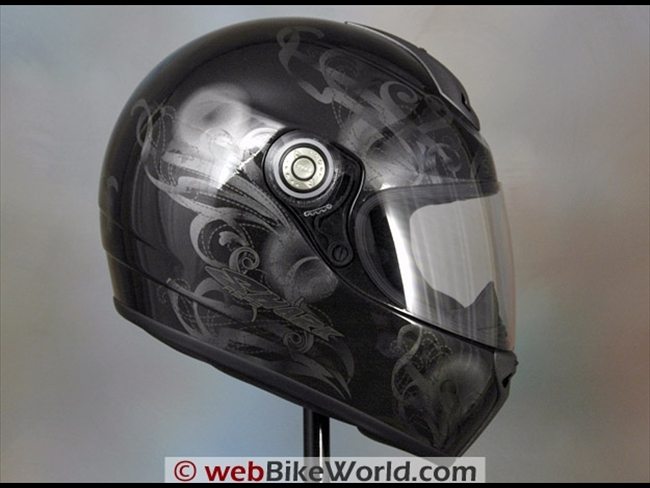

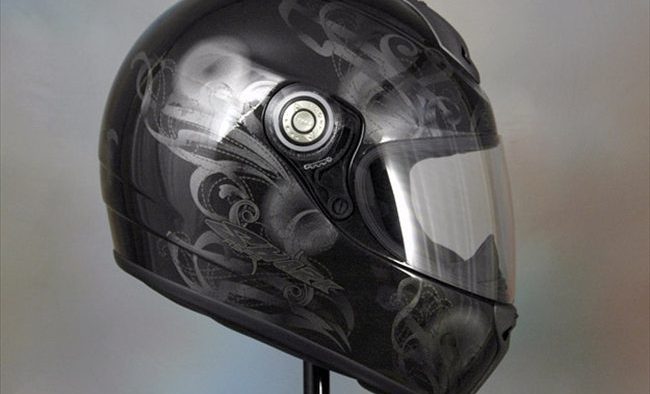
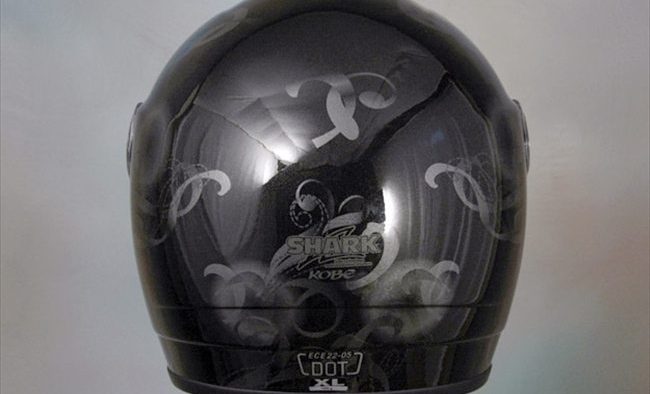

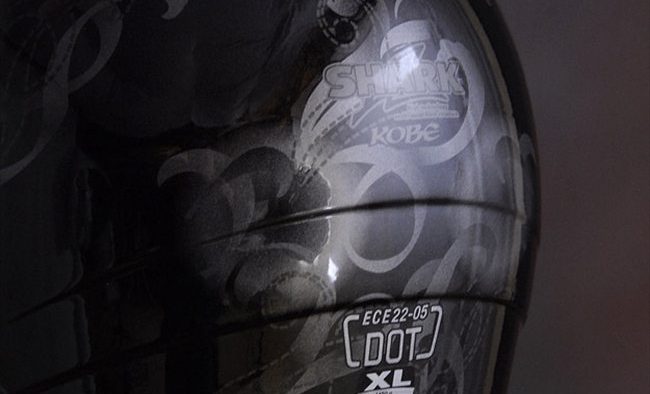

No Comment